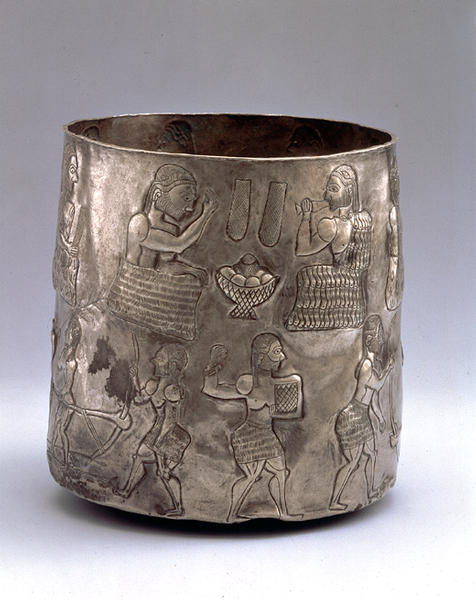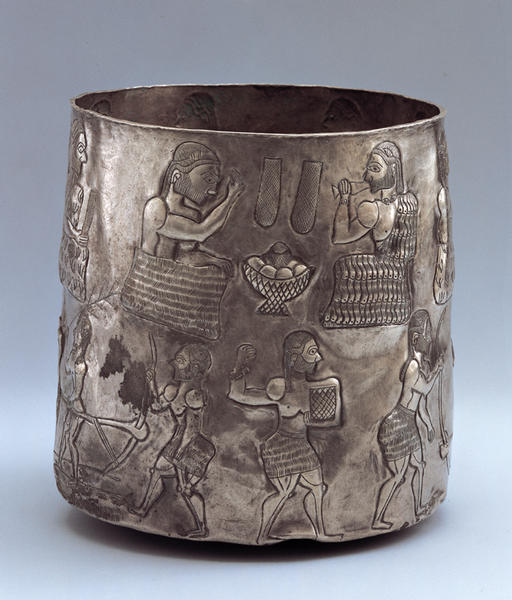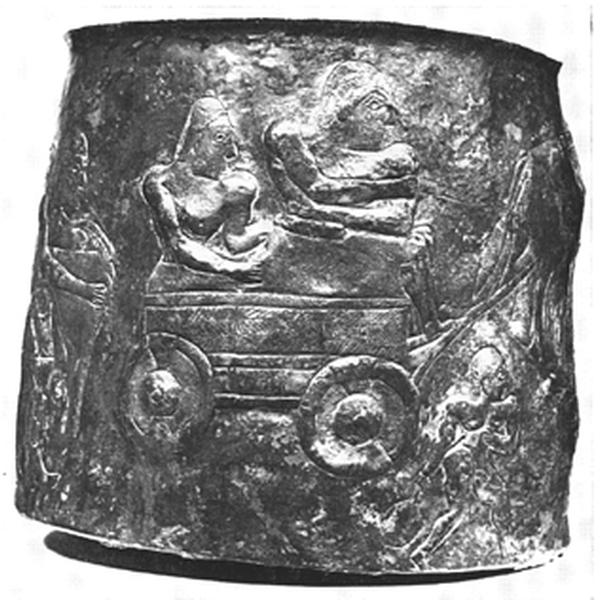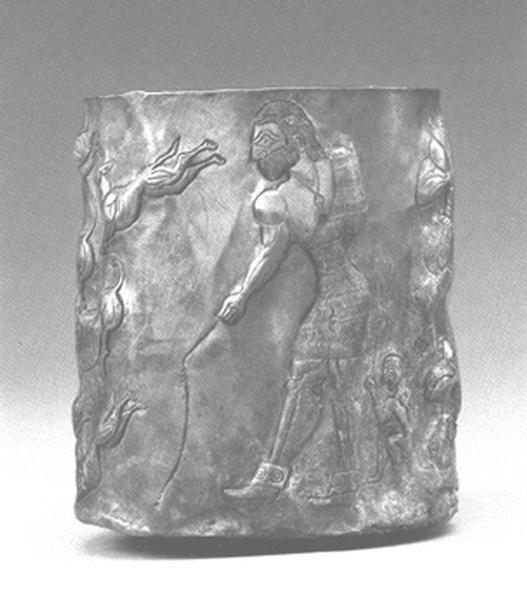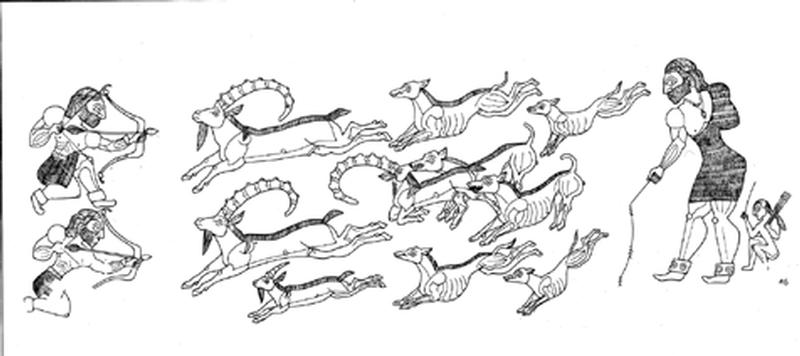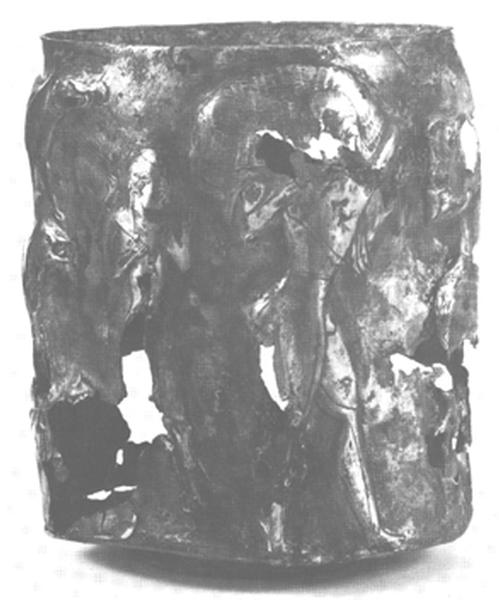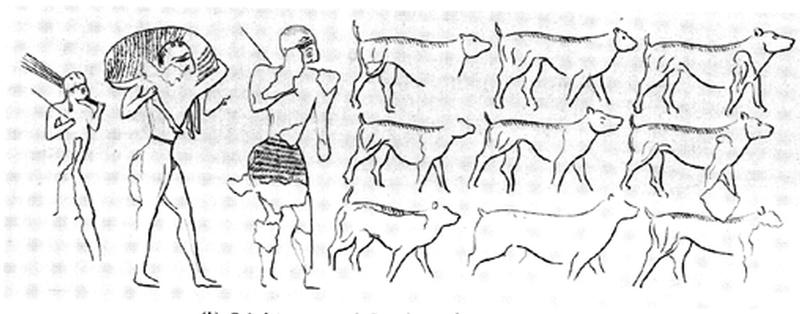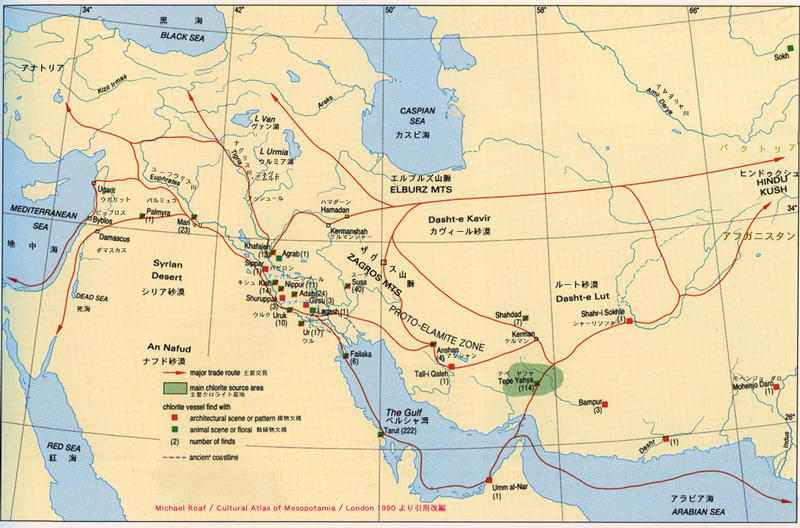農耕饗宴図杯
- バクトリア地方
- 紀元前3千年紀後期-紀元前2千年紀初期
- 銀
- H-12.6 D-9.9
この杯は上段に儀式的情景、下段に牛に鋤を牽かせて農耕を行う情景が表現され、文字を残さなかったこの謎の民族の社会が、当時のメソポタミア文化の影響を受け、また一種の階層社会を形成していた事を物語っている。一説に北から現れたインド・ヨーロッパ系の民族が原地人の上にこのような支配階層を作りあげていったのではないかとも言われている。
古代の文化圏
紀元前三千年紀頃から南イランにエラム王国が興り、このアフガニスタン、東イランの鉱石原料や加工品のメソポタミアへと至る交易を支配しました。
エラムはメソポタミア.シュメールと密接な影響関係があり、またイラン高原、更に中央アジアに至る広範な地域がその文化圏の後背地であったと考えることが出来ます。
・Pierre Amiet/ The Period of Irano-Mesopotamian Contacts/ in 'Early Mesopotamia and Iran: Contact and Conflict 3500-1600 BC' ed.J.Curtis London 1993
婦人座像
鋸壁文円筒杯
牡牛像形分銅
獅子文様壺
ラピスラズリロード
古代中央アジアで産出したラピス・ラズリがエジプトの神像に使われていた事は、当時すでにオリエント世界に広範な交易が存在した事を示しています。
エジプトではすでに紀元前4000年紀後半(3,500~3,000 B.C.頃)には彼の地では産しないラピスラズリを使った宝飾品が出現していますが、少なくとも紀元前三千年紀には、東はインダスの河谷地域からメソポタミアを中継し、西はエジプトに至る、いわゆるラピス・ラズリ=ロードと呼ばれる交易路が存在したと考えられています。
・Horst Klengel/ Handel und Haendler im alten Orient/ 1983 Leipzig
(古代オリエント商人の世界 江上波夫、五味亨訳 山川出版社 1983)
婦人座像
鋸壁文円筒杯
牡牛像形分銅
獅子文様壺
描かれている図像について
この銀杯の図像は上下二段に分かれ、上段は座る人物が8人、下段は明かに農耕の場面をあらわしています。
この銀杯に見られる牛の図像は、同地域の分銅にもたいへん類似したものが見られこの中央アジアの特徴を示しています。
上段の、衣をつけて座る一群の人物の姿は、同地域の石製婦人坐像、エラムの銀壺や石製神像・人物像等に見られる姿に近いものがあります。
上段には紡錘形の貴石を頭だけにつけた人物が、頭と頸、そして手首にもそれをつけ杯から何物かを飲んでいる人物の前に対面し、右手を内側に向けて頭に上げ挨拶をしている場面が描かれています。
前者の後には6人の無装飾の人物が続き、その中には献上物が入っているかと思われる四角い物体を携えている人物がいます。
これはしばしば饗宴の場面とよばれますが、実際に飲み物を口にしているのは場面のいちばん右の人物のみで、他の人物には口の表現さえもありません。おそらく彼等の至上者に対し捧げ物を行っている場面であると想像されます。
左に列をなす人物の最後部では到着間もないとおぼしき人物とそのすぐ前の人物とで、右手を頭にあてがう前述の特有な挨拶を交わしています。
この一群の人物は、右端の至上者に伺候する人々で、右から二番目の人物が至上者の次に身分の高い存在である事を暗示しています。
その下では牛に鋤を引かせ土地を耕す農耕の場面が描かれています。これらの場面を総合する時、当時何等かの組織化と分業の行われた階級的社会があったと想像されています。
古代社会の表現
この銀杯には他に一連のバクトリアのものと思われる類似の三つの銀杯があります。
一つはメトロポリタン美術館レウ゛ィ・ホワイトコレクションの猟犬を使っての狩猟の場面が描かれているもの(M杯)、他の二つはルーヴル美術館(L杯)と個人の所蔵になるもの(A杯)ですが、ともに狩猟から引き揚げる場面が描かれているものと考えられます。
四つの銀杯に共通して、頭あるいは頸に紡錘型の宝飾品をつけた人物が登場します。彼等は他の宝飾品をつけていない人物とは区別されているようですが、これらの宝飾品は一種の身分の表現ではないかと思われます。
それを頭と頸につけた人物が登場するM杯では猟犬を鞭で山羊の群れにけしかけています。
それを頭だけにつけた人物が登場するA杯とL杯では共に狩猟から帰る場面で、L杯では牛に引かせた車を駆り、A杯では猟犬を先頭にそのすぐ後を鞭のような棒を持って歩いています。どちらもその後に獲物を運ぶ人物を従えています。
事実当時(紀元前三千年紀末~二千年紀)の遺跡からは巨大な砦とその内部の神殿が見つかっていますし、多くの武器が発掘されています。
宗教的な祭主であるとともに強力な軍事的統制力を持った首長が存在し、その下にはいくつかの階層があったのでしょう。
彼等は牛にひかせた鋤で農耕を行い、車を駆り、家畜を飼い、狩猟を行いました。これらに描かれているものは一種の儀式的な狩猟であったのかも知れません。
これは重大な変化でした。それは北の方、ユーラシアステップから現われた先進文化だったと言われ、やがてオリエント世界を大統一するに至るイラン民族の先駆的存在に相当する遊牧のインド・ヨーロッパ系民族であったのではないかと考えられています。
・Pierre Amiet/ Iconographie de la Bactriane Proto- historique/ Anatorian Studies 33
1983 ; AU-DELA D'ELAM/ Archaeologische Mitteilungen Aus Iran Band19 1986
・Holly Pittman/ 'Silver cylindrical cup'in "GLORIES OF THE PAST" exhibition catalogue/
The Metropolitan Museum of Art 1990
Catalogue Entry
A fine metalworking tradition appears to have developed in western Central Asia in the late third to the early second millennium B.C. Based on comparisons with excavated pottery types and with finds in the so-called Fullol hoard of objects from northern Afghanistan,1 a number of gold and silver vessels have been attributed to Bronze Age Bactria. Perhaps the most exceptional are cylindrical silver vessels with elaborate figural scenes executed in low relief with incised details, all of which may come from a single workshop.
On this example,2 bearded and moustached male banqueters wearing fillets in their bound long hair are seated in a row above men and boys plowing a field. The main personage in this upper row, who faces left, is distinguished by an elliptically shaped bead on his fillet; he also wears a necklace and bracelet with similar beads, all bearing hatched patterns that might suggest veined stone such as agate. A robe with very clearly rendered individual tufts covers one arm entirely and envelops the rectangular form of his lower body. The man's exposed right arm is raised to hold a tall footed beaker to his mouth (this is the only figure to have a defined mouth). In front of him are a footed fruit bowl, a pair of tall vessels, and a second seated figure wearing a robe with a herringbone pattern. The proper right arm of this figure is raised toward the main personage. Also part of this banqueting scene are five other seated male figures, their garments distinguished alternatively by individual tufts or horizontal rows of hatchings that form herringbone patterns. Some figures hold beakers and one rests a hand on a large altar-like rectangular object with a crosshatched pattern.
In the scene below, two plows are held by long-haired men wearing short kilts with herringbone patterns. Before them, nude youths holding branches attempt to keep two pairs of oxen under control. Another male figure holds a square object-perhaps a box or even a drum-under one arm, and raises the other one. The figures stand on freshly seeded earth; between the animals is an object with a wavy-line pattern and seed-like elements along the top edge. Although difficult to interpret, this could indicate landscape in viewed from above or a vessel in profile.
While iconographic elements such as the garments connect the imagery on this cup to the art of Mesopotamia and Elam, certain aspects of style are very distinctive. In particular, a strong interest in the placement of human and animal figures in space is manifest. The oxen in the background are darkened with hatched lines to clearly distinguish them from those in the foreground.3 The muscular shoulders of the human figures may be depicted in profile or in three-quarter view, and they may have one rather than two nipples showing. The two plows, one seen from the front and the other from the back, are placed behind one and in front of the other nude youth. An interest in the use of patterning to define the textures of garments and objects is also evident.
In style, this cup is closely related to a silver vessel in the Levy-White collection.4 The main personage in a hunting scene there bears a close resemblance to the main figure on the present cup. He is bearded, with a well-delineated mouth, and has elliptical beads both in his hair and around his neck. A figure with similar features appears on another cup, which depicts the aftermath of a successful hunt.5
JA
1. Amiet 1988b, pp. 136, 161, describes this hoard (like the "Astrabad treasure" from Iran with related material) as a contrived collection of objects from clandestine excavations in northern Afghanistan; see Tosi and Wardak 1972, pp. 9-17.
2. See Amiet 1986, pp. 328-29, fig. 202; Pottier 1984, pp. 73, 212, pl. xxx, fig. 250; Deshayes 1977, pp. l04-5; Amiet 1988b, p. 136, fig. 9.
3. This convention is also used on a cylindrical cup in the Louvre, with a chariot scene: see Amiet 1988b, p. 163, fig. 6.
4. See Pittman 1990, pp. 43-44, no. 30.
5. Amiet 1986, pp. 326-27, fig. 201.
解説(古代バクトリア遺宝展)
前三千年紀後期―前二千年紀初期
銀
高12.2-12.6 cm 径9.5-9.9 cm
この銀杯の器壁に刻まれた意匠は上下2段に分かれ、上段に儀礼的場面、下段に牡牛を使った農耕の場面が見られる。上段の場面は饗宴とも見られるが、8人の座した人物のうち右奥左向きの人物のみが食物を前に口を開け杯を傾けている。彼は頭部、首、手首に縞瑪瑙らしき宝飾品をつけ衣服も上等なものをまとい、身分の高い存在であることを示している。その直前に対面し敬礼らしき仕草をしている人物は頭部のみにこの宝飾品をつけているが、他の6人は何もつけていない。これは明確な身分の描き分けであるとも考えられる。この敬礼あるいは挨拶の形態は、この人物の列の最後部の2人にも見られる。
下段には2頭の牡牛に鋤を引かせ耕耘し播種する場面が展開している。その牛を木の枝で追う仕草をする裸形で小さい人物と、鋤につかまりあるいは播種する人物との間にも明確な描き方の区別がつけられている。他に同時代のものとされる狩猟場面を描いた銀杯の類例が知られているが、同じように身分の高い人物と思われる表現に、縞瑪瑙と思しき宝飾品が見られる。この短いキルトと筋肉を強調した体躯の表現は西中央アジアから東イランの前三千年紀から前二千年紀にかけての特徴であり、牡牛の体躯に見られる前半身の毛並み表現や後脚の筋肉表現はバクトリア文化に特有のものである。バクトリアの同時代の遺跡からは巨大な砦とその内部の神殿、そして多くの武器も見つかっており、宗教上の祭主であるとともに強力な軍事上の強制力をもった首長が存在したと想像されている。彼らは文字をもたなかったが、この器はそのような彼らの社会の一側面を如実に描き出している。
Catalogue Entry(Bac#007)
Late 3rd‐early 2nd millennium B.C.
Silver
H. 12.2-12.6 cm, Dia. 9.5-9.9 cm
Designs are incised into an upper and lower register on the walls of this silver cup, with the upper register showing a ritual scene and the lower register showing a farming scene with oxen. The upper register scene has also been thought to be a banqueting scene, but of the eight seated figures, only the figure on the far right facing to the left is shown with food before him and raising his cup to his mouth. This figure is also shown with his head, neck and wrists wearing jewels that appear to be onyx, and higher grade of clothing, both clearly symbols of his high rank. The figure directly in front of this high ranking figure is shown in a position of obeisance, and he has jewelry only on his head. The other six figures have no jewelry. These devices clearly are thought to indicate the respective ranks of these figures. This offertory or welcoming posture can also be seen in the last two figures in this row.
The two oxen in the lower register are shown pulling plows during a tilling and planting scene. The small naked figure wields a stick to urge on the oxen, and there are clear divisions drawn between the figures holding onto the plow and those sowing seeds. There are similar examples of silver cups from this period with hunting scenes, and in the same manner, those who are thought to be high-ranking figures are shown adorned with jewelry thought to be made of onyx. This body expression with short kilted skirt and emphasized musculature was characteristic of the western Central Asia through Eastern Iran from the 3rd millennium BC through the 2nd millennium BC. The arranged hair expression on the forequarters of the oxen and the musculature of the back legs are also unique to Bactrian culture. The ruins of a massive Bactrian fort of this same period have been excavated, along with temples inside the fort and large numbers of weapons, and we can thus imagine the existence of a ruler who was powerful both in politics and in military might, all while acting as the head cleric of the religion. These people did not have writing, but this vessel clearly depicts one aspect of their society.
